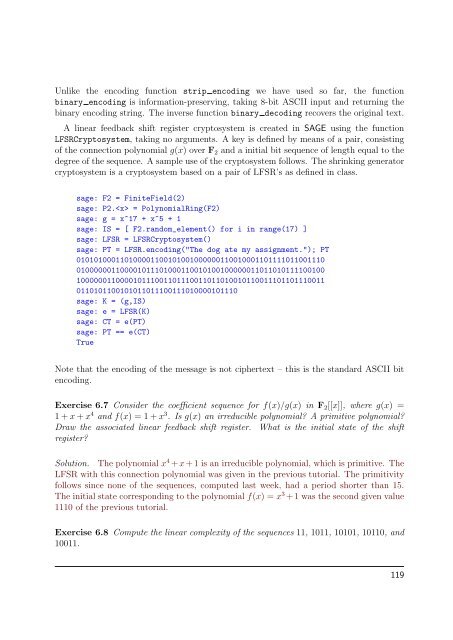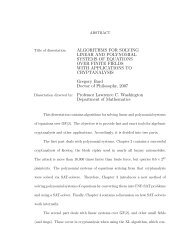Unlike the encoding function strip encoding we have used so far, the functionbinary encoding is information-preserving, taking 8-bit ASCII input and returning thebinary encoding string. The inverse function binary decoding recovers the original text.A linear feedback shift register cryptosystem is created in SAGE using the functionLFSRCryptosystem, taking no arguments. A key is defined by means of a pair, consistingof the connection polynomial g(x) over F 2 and a initial bit sequence of length equal to thedegree of the sequence. A sample use of the cryptosystem follows. The shrinking generatorcryptosystem is a cryptosystem based on a pair of LFSR’s as defined in class.sage: F2 = FiniteField(2)sage: P2. = PolynomialRing(F2)sage: g = x^17 + x^5 + 1sage: IS = [ F2.random_element() for i in range(17) ]sage: LFSR = LFSRCryptosystem()sage: PT = LFSR.encoding("The dog ate my assignment."); PT0101010001101000011001010010000001100100011011110110011100100000011000010111010001100101001000000110110101111001001000000110000101110011011100110110100101100111011011100110110101100101011011100111010000101110sage: K = (g,IS)sage: e = LFSR(K)sage: CT = e(PT)sage: PT == e(CT)TrueNote that the encoding of the message is not ciphertext – this is the standard ASCII bitencoding.Exercise 6.7 Consider the coefficient sequence for f(x)/g(x) in F 2 [[x]], where g(x) =1 + x + x 4 and f(x) = 1 + x 3 . Is g(x) an irreducible polynomial? A primitive polynomial?Draw the associated linear feedback shift register. What is the initial state of the shiftregister?Solution. The polynomial x 4 + x + 1 is an irreducible polynomial, which is primitive. TheLFSR with this connection polynomial was given in the previous tutorial. The primitivityfollows since none of the sequences, computed last week, had a period shorter than 15.The initial state corresponding to the polynomial f(x) = x 3 +1 was the second given value1110 of the previous tutorial.Exercise 6.8 Compute the linear complexity of the sequences 11, 1011, 10101, 10110, and10011.119
Solution. The linear complexity of the sequences 11, 1011, 10101, 10110, and 10011 is 1,2, 2, 2, and 3. The initial values follow from extending the sequences with period 1, 3, 2,and 3, with connection polynomials x + 1, x 2 + x + 1, x 2 + 1, and x 2 + x + 1. The thirdsequence can be extended to a sequence with period no better than 4, so it generated byno LFSR of length 2. A possible connection polynomial is x 4 +1 = (x+1) 4 , giving a LFSRof length 4 which generates it. However, the divisor x 3 + x 2 + x + 1 = (x + 1) 3 defines arecursion for a LFSR of length 3. Hence the linear complexity for this sequence is 3.Exercise 6.9 Compute the first 8 terms of the linear complexity profile of the coefficientsequence from Exercise 1.Solution. The first 8 terms of the linear complexity profile for the sequence of the firstquestion are:[1, 1, 1, 3, 3, 3, 4, 4].On the other hand, since the sequence is generated by a LFSR of length 4 we know thatthe full infinite sequence becomes constant at 4.Exercise 6.10 Practice encoding and enciphering with the LFSR stream cryptosystem.The function binary decoding easily converts this back to ASCII text. Use these functionsto verify that PT is just the binary encoding of the original plaintext message and that theciphertext is enciphered.Solution. The encoding and decoding member functions associated with a LFSR are justa wrapper around binary encoding and binary decoding:sage: LFSR = LFSRCryptosystem()sage: PT = LFSR.encoding(’The dog ate my assignment.’); PT0101010001101000011001010010000001100100011011110110011100100000011000010111010001100101001000000110110101111001001000000110000101110011011100110110100101100111011011100110110101100101011011100111010000101110sage: LFSR.decoding(PT)’The dog ate my assignment.’We verify using that binary decoding that the binary string also returns the ASCIImessage:sage: PT.binary_decoding()’The dog ate my assignment.’120 Appendix C. Solutions to Exercises
- Page 1 and 2:
Author (David R. Kohel) /Title (Cry
- Page 4 and 5:
CONTENTS1 Introduction to Cryptogra
- Page 6:
PrefaceWhen embarking on a project
- Page 10 and 11:
information. We introduce here some
- Page 12 and 13:
ut strings in A ∗ map injectively
- Page 14 and 15:
CHAPTERTWOClassical Cryptography2.1
- Page 16 and 17:
LV MJ CW XP QO IG EZ NB YH UA DS RK
- Page 18 and 19:
As a special case, consider 2-chara
- Page 20 and 21:
Note that if d k = 1, then we omit
- Page 22:
ExercisesSubstitution ciphersExerci
- Page 25 and 26:
Ciphertext-only AttackThe cryptanal
- Page 27 and 28:
of size n, suppose that p i is the
- Page 29 and 30:
Note that ZKZ and KZA are substring
- Page 31:
Checking possible keys, the partial
- Page 34 and 35:
sage: X = pt.frequency_distribution
- Page 36 and 37:
CHAPTERFOURInformation TheoryInform
- Page 38 and 39:
For each of these we can extend our
- Page 40 and 41:
in terms of the cryptosystem), then
- Page 42 and 43:
CHAPTERFIVEBlock CiphersData Encryp
- Page 44 and 45:
Deciphering. Suppose we begin with
- Page 46 and 47:
The Advanced Encryption Standard al
- Page 48 and 49:
1. Malicious substitution of a ciph
- Page 50 and 51:
locks M j−1 , . . . , M 1 as well
- Page 52:
where X = K ⊕ M = (X 1 , X 2 , X
- Page 55 and 56:
6.2 Properties of Stream CiphersSyn
- Page 57 and 58:
Exercise. Verify that the equality
- Page 59 and 60:
n 2 n − 11 12 33 74 155 316 637 1
- Page 61 and 62:
Exercise 6.6 In the previous exerci
- Page 63 and 64:
Exercise 6.9 Compute the first 8 te
- Page 65 and 66:
which holds since −4 = 17 + (−1
- Page 67 and 68:
must therefore have a divisor of de
- Page 69 and 70:
Shrinking Generator cryptosystemLet
- Page 72 and 73:
CHAPTEREIGHTPublic Key Cryptography
- Page 74 and 75: Initial setup:1. Alice and Bob publ
- Page 76 and 77: We apply this rule in the RSA algor
- Page 78 and 79: the discrete logarithm problem (DLP
- Page 80 and 81: Man in the Middle AttackThe man-in-
- Page 82: Exercise 8.6 Fermat’s little theo
- Page 85 and 86: k < p − 1 with GCD(k, p − 1) =
- Page 88 and 89: CHAPTERTENSecret SharingA secret sh
- Page 90: using any t shares (x 1 , y 1 ), .
- Page 93 and 94: sage-------------------------------
- Page 95 and 96: sage: x.is_unit?Type:builtin_functi
- Page 97 and 98: Python (hence SAGE) has useful data
- Page 99 and 100: sage: n = 12sage: for i in range(n)
- Page 101 and 102: sage: I = [55+i for i in range(3)]
- Page 103 and 104: sage: I = [7, 4, 11, 11, 14, 22, 14
- Page 105 and 106: ExercisesRead over the above SAGE t
- Page 107 and 108: 102
- Page 109 and 110: Solution. The block length is the n
- Page 111 and 112: Solution.below.The coincidence inde
- Page 113 and 114: analysis of the each of the decimat
- Page 115 and 116: arbitrary permutation of the alphab
- Page 117 and 118: In order to understand naturally oc
- Page 119 and 120: We do this by first verifying the e
- Page 121 and 122: Solution.None provided.Linear feedb
- Page 123: Multiplying each through by the con
- Page 127 and 128: If a, b, and c are as above, then f
- Page 129 and 130: Exercise 8.5 Use SAGE to find a lar
- Page 131 and 132: Solution. Now we can verify that e
- Page 133 and 134: which has no common factors with p
- Page 135 and 136: sage: p = 2^32+61sage: m = (p-1).qu
- Page 137 and 138: sage: a5 := a^n5sage: c5 := c^n5sag
- Page 139 and 140: The application of this function E
- Page 141 and 142: 5. (∗) How many elements a of G h
- Page 143: 1. The value f(0) of the polynomial
















